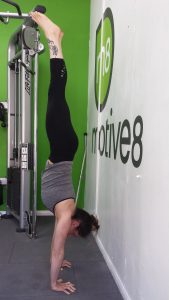Posted on July 02, 2018 by Emily Forbes
So you wanna learn to handstand? You’ve seen the Instagram posts of everyone balancing on their hands. You could do it when you were 10 years old. And now you fancy doing it again. How hard can it be right (cue, much harder than you remember)? If it is something you are serious about, then here I share my handstand journey and what it will really take to get you on your hands.
The handstand reality: Have you got what it takes?
- Decide that it is something you want to do and dedicate time and effort into it, consistently! I made the decision in August (2017) that it was something I was going to master. Since then I have attended 4 workshops and practice nearly every day. Sometimes just a few attempts, sometimes hours over the day. Even now it can take me 100 kick-ups to get a 10 second hold.
- Can you do other balancing inversions? I was already proficient in headstand and had a sense of what it’s like upside down and have just unlocked forearm balances. (If you want to attempt these at home, I advise seeking advice from a trained teacher first).
- Do you have the shoulder flexibility? Lift your arms up to your ears with your hands flexed. This is the position you need to be in upside down. If your arms don’t get to your ears you aren’t ever going to be able to get stacked in handstand.
- Now you’ve got your arms by your ears, what’s your back doing? My guess is it’s arched into a nice banana shape (not nice for handstands). You want to engage the core and close the gap between the lower ribs and hips AND keep the arms by the ears. Squeezing your glutes here is going to help reduce the arch.
- You also need to be able to activate your lats and “push” the ground away protracting the shoulders. I have only just discovered this. When my teacher was saying “push the ground away” I thought I was doing just that. I have been working on my latissmus dorsi activation because of a shoulder injury and I can now feel what she was talking about.
- Legs play a very little role in handstands; they can be waving around in the air if you’ve got all the other parts in place. Many people can get into handstand but with poor alignment (banana back) and this is harder to correct in the long run. I’ve been working with correct alignment from beginning.
Things to work on to get you learn to handstand are:
- Core stability, hollow holds and rocks are best for this.
- Recreate the position on the floor that you will be in upside down. In a hollow hold take your arms above your head and push against a wall. Hold for 10 seconds and repeat a few times.
- Work on shoulder mobility. Resistance bands are great for this.
- Practice L-handstands using the wall to build up strength.
- Use the wall for security and alignment. This can be done facing towards or away from it. Or better still get a partner to help.
- Practice kicking up in the middle of the room and falling out of the handstand so you know how to land safely.
- But mostly practice. Practice. Practice.
Good luck. Don’t forget to tag us in your handstand pictures @motive8_north


